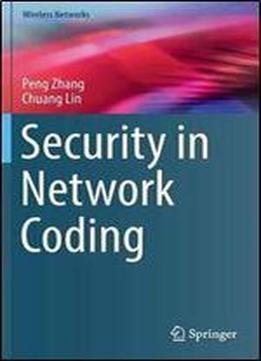
Security In Network Coding (wireless Networks)
by Peng Zhang /
2016 / English / PDF, DjVu
2 MB Download
This book covers a series of security and privacy issues in network coding, and introduces three concrete mechanisms to address them. These mechanisms leverage traditional cryptographic primitives and anonymous protocols, and are redesigned to fit into the new framework of network coding. These three mechanisms are MacSig, a new message authentication method for network-coded systems P-Coding, a new encryption scheme to secure network-coding-based transmissions and ANOC, a new anonymous routing protocol that seamlessly integrates anonymous routing with network coding.
Along with these three mechanisms, the authors provide a review of network coding's benefits, applications, and security problems. Also included is a detailed overview of security issues in the field, with an explanation of how the security issues differ from those in traditional settings. While network coding can help improve network performance, the adoption of network coding can be greatly limited unless security and privacy threats are addressed.
Designed for researchers and professionals, Security in Network Coding explores major challenges in network coding and offers practical solutions. Advanced-level students studying networking or system security will also find the content valuableAuthors: Zhang, Peng, Lin, Chuang
Provides a comprehensive treatment of network coding security
Introduces a novel hybrid-key based authentication method
Offers a new lightweight encryption method
This book covers a series of security and privacy issues in network coding, and introduces three concrete mechanisms to address them. These mechanisms leverage traditional cryptographic primitives and anonymous protocols, and are redesigned to fit into the new framework of network coding. These three mechanisms are MacSig, a new message authentication method for network-coded systems P-Coding, a new encryption scheme to secure network-coding-based transmissions and ANOC, a new anonymous routing protocol that seamlessly integrates anonymous routing with network coding.
Along with these three mechanisms, the authors provide a review of network coding's benefits, applications, and security problems. Also included is a detailed overview of security issues in the field, with an explanation of how the security issues differ from those in traditional settings. While network coding can help improve network performance, the adoption of network coding can be greatly limited unless security and privacy threats are addressed.
Designed for researchers and professionals, Security in Network Coding explores major challenges in network coding and offers practical solutions. Advanced-level students studying networking or system security will also find the content valuable
Number of Illustrations and Tables
16 b/w illustrations, 18 illustrations in colour
Topics
Systems and Data Security
Computer Communication Networks
Communications Engineering, Networks











